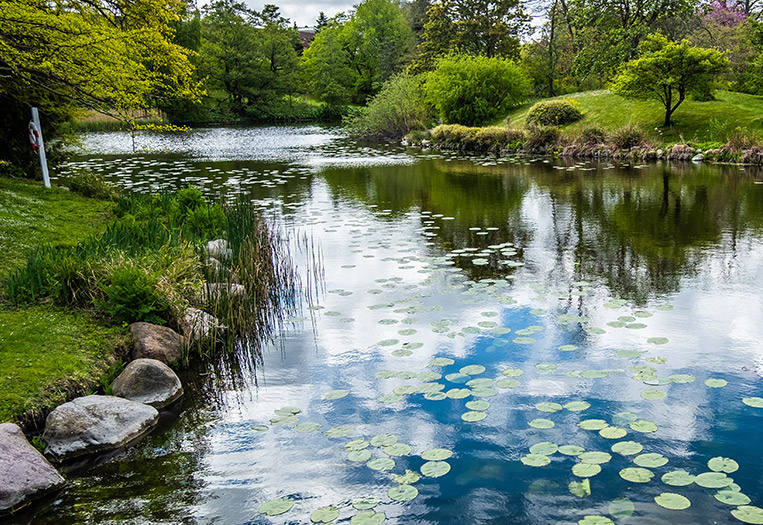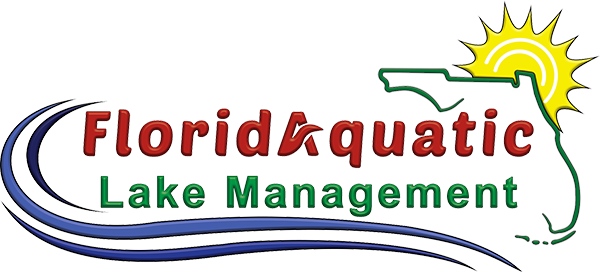Water/Sediment Sampling
Maintaining good water quality is critical to pond management. Proper levels of pond productivity are required to sustain a fish population, which supports wildlife. Poor water quality is the most common cause for poor pond production.
Turbidity
Turbid or muddy water should not be confused with stained or green colored water. Turbidity is caused by clay and silt particles held in suspension in the water column. Colored water that is clear, but resembles tea, is caused by tannins and lignins leached from certain upland soils.
Muddy water can reduce sunlight penetration, which will disrupt biological production. Newly dug ponds will usually experience temporary turbidity; however, if the pond fails to clear within three or four months, take corrective measures. The most common source of turbidity is erosion from barren shorelines and upland areas. Sodding, seeding and aquascaping will reduce this source.
Resuspension of clay and silt can result from high winds, livestock wading along the shoreline, and the burrowing actions of crayfish and certain fishes. Planting trees to buffer winds and fencing livestock to restricted areas of the pond are effective. If crayfish are the suspected cause, the establishment of largemouth bass and bream will reduce crayfish populations.
Controlling pH
Ponds constructed on acidic soils can have low pH (highly acidic), which restricts the pond’s biological productivity. Fish growth, reproduction and survival can be affected by pH. Ideal pH should range from 6.0 to 8.0.

Managing Pond Fertility
You can manage your pond at different levels of fertility depending on your desires and objectives. Infertile ponds produce low fish crops; more fertile ponds produce higher yields. Artificial methods to increase production include fertilization and supplemental feeding. In many ponds, however, nutrient inputs are excessive and problems develop from over enrichment.
One way to determine a pond’s fertility is to measure water transparency during spring and summer. You can devise a simple tool to do the job. Cut a 2-inch square of white plastic from a bleach bottle and fasten it to the end of a wooden yardstick. Push this apparatus into the pond vertically until the white plastic cannot be seen. Note the depth at which the plastic first disappears.
If the plastic disappears between 16 and 36 inches, your pond has a desirable productivity level. Visibility greater than 36 inches indicates low production. In this situation, fertilization can increase fish production. By adding nutrients to the water, you will stimulate algal growth and strengthen the food chain. Fertilization is an expensive, time-consuming and complicated process. If done improperly, undesirable effects will result. You should fertilize only if your pond is infertile and you strongly desire maximum fish production. Overfertilization will cause fish kills; consult a FWC biologist before starting a fertilization program.
If visibility is less than 16 inches, it is important to distinguish whether turbidity or suspended microscopic algae is to blame. Healthy algae blooms give the water a green hue. If the pond is over enriched, sources of nutrient inputs should be identified and eliminated. Ponds located near septic drain fields, fertilized lawns, cultivated crops and livestock are often overloaded with nutrients. Consider these factors before pond construction. Fencing the pond from livestock, discontinuing use of fertilizers within 20 feet of the pond, and constructing swales or berms adjacent to the pond edge will help reduce nutrient inputs. Do not allow lawn clippings, leaves or any other organic material to enter your pond. Leave an “unmanicured” buffer of desirable vegetation between lawns, agricultural fields, pastures, and the waterbody. This helps reduce nutrients and erosion. Retention ponds required for new developments are extremely vulnerable to poor water quality since, by design, they collect runoff from streets, parking lots and lawns. However, if homeowners adhere to the above suggestions, those too can provide a waterbody for recreation and aesthetic enjoyment.
Fish Kills, Disease and Parasites
Most fish kills result from low DO conditions that over fertile ponds commonly experience. Algae and aquatic plants using oxygen in the absence of sunlight (nighttime or cloudy days), decaying vegetation or the input of runoff containing organic matter can deplete oxygen levels. Ponds located near coastal areas may experience saltwater intrusion from surface or groundwater sources. Rapid changes in temperature, DO, salinity and pH can stress the fish population and cause a fish kill resulting from a secondary bacterial or viral infection. Disease outbreaks may also occur in crowded fish populations that compete for space, food or reproductive advantage. Spawning stress occurs because fish are expending a lot of energy, feeding less and are in close proximity to each other. The larger the waterbody, the less that can be done to stop a fish kill once it has begun. It is best to let the kill run its course.
The best way to prevent a fish kill is to maintain good water quality. If you begin an intensive supplemental feeding program, sudden stoppage may create food shortages and stress. If DO related fish kills occur on a regular basis, you may want to install an aeration system. They can help maintain adequate DO levels and reduce the chances of a fish kill.


